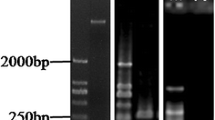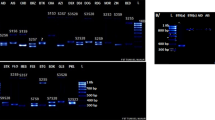Abstract
The pear cultivar ‘Zaoguan’ (S 4 S 34) is the a self-compatible descendant of ‘Yali’ (S 21 S 34 ) × ‘Qingyun’(S 4 S 9 ). Two self-incompatible cultivars ‘Xinya’ and ‘Yaqing’, also S-genotyped as S 4 S 34 for the S-RNase gene, were used as controls. Field pollination data revealed that ‘Zaoguan’ displayed SC, whereas ‘Xinya’ and ‘Yaqing’ showed self-incompatibility (SI) upon self-pollination. Reciprocal pollinations between the varieties showed that most of the ‘Zaoguan’ flowers pollinated with ‘Xinya’ or ‘Yaqing’ pollen set fruits but that few of the ‘Xinya’ or ‘Yaqing’ flowers set fruit when pollinated with ‘Zaoguan’ pollen. The pollen performance was monitored with fluorescence microscopy, and we observed that ‘Zaoguan’ accepted self-pollen as well as ‘Xinya’ or ‘Yaqing’ pollen, whereas ‘Xinya’ or ‘Yaqing’ rejected self-pollen and ‘Zaoguan’ pollen. The S 34-RNase but not the S 4-RNase could be detected in all selfed progeny of ‘Zaoguan’. Comparisons of the 2D-PAGE profiles of the stylar extracts from the three cultivars showed that the S4-RNase protein expressed normally, but the S34-RNase of ‘Zaoguan’ was not found. Thus, we concluded that the stylar S34 products were defective in ‘Zaoguan’ and that the S 4-allele functioned normally. The nucleotide sequences of the S 4- and S 34-RNase of ‘Zaoguan’ showed no differences from those of ‘Xinya’ or ‘Yaqing’, and they transcribed normally. These results indicate that SC in ‘Zaoguan’ was due to the loss of the S34-RNase caused by unknown post-transcriptional factors.







Similar content being viewed by others
References
Altschul SF, Gish W, Miller W, Myers EW, Lipman DJ (1990) Basic local alignment search tool. J Mol Biol 215:403–410
Anderson MA, Cornish EC, Mau SL, Williams EG, Hoggart R, Atkinson A, Bonig I, Grego B, Simpson R, Roche P, Haley JD, Penschow J, Niall HD, Tregear GW, Coghlan JP, Crawford RJ, Clarke AE (1986) Cloning of cDNA for a stylar glycoprotein associated with expression of self-incompatibility in Nicotiana alata. Nature 321:38–44
Bosković R, Tobutt KR, Duval H, Batlle I, Dicenta F, Vargas FJ (1999) A stylar ribonuclease assay to detect self-compatible seedlings, on almond progenies. Theor Appl Genet 99:800–810
Damerval C, de Vienne D, Zivy M, Thiellement H (1986) Technical improvements in two-dimensional electrophoresis increase the level of genetic variation detected in wheat-seedling proteins. Electrophoresis 7:52–54
de Nettancourt D (1977) Incompatibility in Angiosperms. Springer, Berlin
de Nettancourt D (2001) Incompatibility and incongruity in wild and cultivated plants. Springer, Berlin
Doyle JI, Doyle JL (1987) A rapid DNA isolation procedure for small quantities of fresh leaf tissue. Phytochem Bull 19:11–15
Hiratsuka S, Nakashima M, Kamasaki K (1999) Comparison of an S-protein expression between self-incompatible and -incompatible Japanese pear cultivars. Sex Plant Reprod 12(2):88–93
Hiratsuka S, Zhang SL, Nakagawa E, Kawai Y (2001) Selective inhibition of the growth of incompatible pollen tubes by S-protein in the Japanese pear. Sex Plant Reprod 13:209–215
Ishimizu T, Inoue K, Shinonaka M, Saito T, Terai O, Norioka S (1999) PCR-based method for identifying the S-genotypes of Japanese pear cultivars. Theor Appl Genet 98:961–967
Kim HT, Hirata Y, Shin YU, Hwang HS, Hwang JH, Shin IS, Kim DI, Kang SJ, Kim HJ, Shin DY (2004) A molecular technique for selection of self-compatible varieties of Japanese pear (Pyrus pyrifolia Nakai). Euphytica 138:73–80
Li MF, Han ZH, Shu HR, Li TZ (2009) Molecular analysis of two Chinese pear (Pyrus bretschneideri Rehd.) spontaneous self-compatible mutants, Yan Zhuang and Jin Zhui. Plant Biol 11:774–783
Livak KJ, Schmittgen TD (2001) Analysis of relative gene expression data using real time quantitative PCR and the 2−∆∆CT method. Methods 25:402–408
Matsumoto S, Komori S, Kitahara K, Imazu S, Soejima J (1999) S-genotypes of 15 apple cultivars and self-compatibility of ‘Megumi’. J Jpn Soc Hort Sci 68:236–241
McClure BA, Haring V, Ebert PP, Anderson MA, Simpson RJ, Sakiyama F, Clarke AE (1989) Style self-incompatibility gene products of Nicotiana alata are ribonucleases. Nature 342:955–957
O’Farrell PH (1975) High resolution two-dimensional electrophoresis of proteins. J Biol Chem 250:4007–4021
Okada K, Tonaka N, Moriya Y, Norioka N, Sawamura Y, Matsumoto T, Nakanishi T, Takasaki-Yasuda T (2008a) Deletion of a 236 kb region around S 4 -RNase in a stylar-part mutant S sm 4 - haplotype of Japanese pear. Plant Mol Biol 66:389–400
Okada K, Tonaka N, Takasaki T, Matsumoto T, Sawamura Y (2008b) Selection of self-compatibility trees by S sm 4 -haplotype specific marker in Japanese pear. Acta Hort (ISHS) 800:401–408
Sanzol J (2009) Pistil-function breakdown in a new S-allele of European pear, S 021 , confers self-compatibility. Plant Cell Rep 28:457–467
Sassa H, Hirano H, Ikehashi H (1993) Identification and characterization of stylar glycoproteins associated with self-incompatibility genes of Japanese pear, Pyrus serotina Rehd. Mol Gen Genet 241:17–25
Sassa H, Nishio T, Kowyama Y, Hirano H, Koba T, Ikehashi H (1996) Self- incompatibility (S) alleles of the Rosaceae encode members of a distinct class of the T2/S-ribonuclease superfamily. Mol Gen Genet 250:547–557
Sassa H, Hirano H, Nishio T, Koba T (1997) Style-specific self-incompatibility mutation caused by deletion of the S-RNase gene in Japanese pear (Pyrus serotina). Plant J 12:223–227
Sato Y, Kurihara A, Abe K, Ogata T, Kajiura I, Kotobuki K, Machida Y (1988) Studies on the mode of inheritance of self-compatibility in Japanese pear. J Jpn Soc Hort Sci 57(Suppl. 2):76–77
Sato Y, Abe K, Saito T, Kotobuki K (1992) Selection of S-gene homozygotes and its utilization for S-genotype analysis of ‘Osa-Nijisseiki’. J Jpn Soc Hort Sci 61(Suppl. 2):16–17
Sonneveld T, Tobbutt KR, Vaughan SP, Robbins TP (2005) Loss of pollen S function in two self-compatible selections of Prunus avium is associated with deletion/mutation of an S haplotype-specific F-box gene. Plant Cell 17:37–51
Takasaki T, Okada K, Castillo C, Moriya Y, Saito T, Sawamura Y, Norioka N, Norioka S, Nakanishi T (2004) Sequence of the S 9 -RNase cDNA and PCR-RFLP system for discriminating S 1 - to S 9 -allele in Japanese pear. Euphytica 135:157–167
Tanabe K, Tamura F, Itai A, Hayashi S (2001) New Japanese pear cultivars, ‘Akibae’, ‘Zuishyu’ and ‘Shinjyu’ (in Japanese). J Jpn Soc Hort Sci 70(Suppl 1):220
Tao R, Yamane H, Sugiura A, Murayama H, Sassa H, Mori H (1999) Molecular typing of S-alleles through identification, characterization and cDNA cloning for S-RNases in sweet cherry. J Am Soc Hortic Sci 124:224–233
Tao R, Watari A, Hanada T, Habu T, Yaegaki H, Yamaguchi M, Yamane H (2007) Self-compatible peach (Prunus persica) has mutant versions of the S haplotypes found in self-incompatible Prunus species. Plant Mol Biol 63:109–123
Thompson JD, Higgins DG, Gibson TJ (1994) CLUSTALW: improving the sensitivity of progressive multiple sequence alignment through sequence weighting, positions-specific gap penalties and weight matrix choice. Nucleic Acids Res 22:4673–4680
Tsukamoto T, Hauck NR, Tao R, Jiang N, Iezzoni AF (2006) Molecular characteri- zation of three non-functional S-haplotypes in sour cherry (Prunus cerasus). Plant Mol Biol 62:371–383
Ushijima K, Sassa H, Tao R, Yamane H, Dandekar AM, Gradziel TM, Hirano H (1998) Cloning and characterization of cDNAs encoding S-RNases from almond (Prunus dulcis): primary structural features and sequence diversity of the S- RNases in Rosaceae. Mol Gen Genet 260:261–268
Vilanova S, Badenes ML, Burgos L, Martinez-Calvo J, Llacer G, Romero C (2006) Self-compatibility of two apricot selections is associated with two pollen-part mutations of different nature. Plant Physiol 142:629–641
Wang YT, Li Y, Li X, Liu GS, Han YX (2006) A new self-fruitful pear variety ‘Zaoguan’. Acta Hort Sin 33(6):1401
Watari A, Hanada T, Yamane H, Esumi T, Tao R, Yaegaki H, Yamaguchi M, Beppu K, Kataoka I (2007) A low transcriptional level of Se-RNase in the Se-haplotype confers self-compatibility in Japanese plum. J Am Soc Hortic Sci 132:396–406
Xue YR, Carpenter HGD, Coen ES (1996) Origin of allelic diversity in Antirrhinum S locus RNases. Plant Cell 8:805–814
Zhang SL, Hiratsuka S, Xu GH, Fang JG, Liu YL (2001) Expression and possible role of S 4 (S SM) 4 gene in the styles of self-incompatible pear cultivar and its self- compatible mutant. Acta Bot Sin 43:1172–1178
Zhang YY, Zhang SL, Wu J, Zhang RP, Li XG (2007) Identification of S-genotype in 14 Pear cultivars. J Fruit Sci 24(2):135–139
Acknowledgments
Key Technologies R&D Program of Jiangsu Province, China (BE2010324) and the Postdoctoral Found of Jiangsu Province, China (0902100C).
Author information
Authors and Affiliations
Corresponding authors
Rights and permissions
About this article
Cite this article
Qi, YJ., Wang, YT., Han, YX. et al. Self-compatibility of ‘Zaoguan’ (Pyrus bretschneideri Rehd.) is associated with style-part mutations. Genetica 139, 1149–1158 (2011). https://doi.org/10.1007/s10709-011-9617-6
Received:
Accepted:
Published:
Issue Date:
DOI: https://doi.org/10.1007/s10709-011-9617-6




